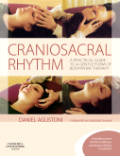
Craniosacral rhythm: a practical guide to a gentle form of bodywork therapy
Agustoni, Daniel
A complete and detailed introduction and overview of soft craniosacral-bodytherapy for beginners and therapists. The book covers aspects on how to give a craniosacral-treatment. Every position is explained in words and with photos. The book includes more than 20 illustrations, 100 black and white photos, and an extended part with FAQ. It includes a detailed treatment-protocol and a poster with a basic-craniosacral-treatment. This is a comprehensive introductory textbook which includes different possibilities of techniques, many practice-tips, FAQ and treatment-poster. * Highly visual text * Clear, simple language and explanations * Suitable for a variety of practitioners in body and energy work * Poster included demonstrating basic positions. INDICE: Section1: And yet the cranium does move: overview, theory, and introduction 1.1 The range and variety of craniosacral treatment - an overview 1.2 Origin and history 1.3 The craniosacral system 1.4 How the craniosacral system relates to other body systems 1.5 The craniosacral rhythm: An expression ofprimary respiration 1.6 The still point 1.7 Self-palpation of the body rhythms on the head, pelvis and thighs 1.8 Indications and contraindications 1.9 Theefficiency of the craniosacral treatment: How many sessions at what time intervals? 1.10 Basic points before beginning treatment 1.11 The resource-orientedapproach 1.12 The dialog prior to treatment 1.13 The treatment record 1.14 Position 1.15 Therapeutic dialog 1 1.16 Interactive work as the companion in theprocess Section 2: Treatment and balancing of the craniosacral system 2.1 Theart of gentle touch 2.2 Golden rules before you begin 2.3 Whole-body assessment 2.4 Release of the transverse layers of connective tissue 2.5 Inviting inducing still points 2.6 Self-treatment techniques for the head 2.7 Treating the head 2.8 Releasing the temporomandibular joints 2.9 The cranial vault hold: 'Listening to the cranial orchestra' 2.10 Harmonization and integration of head and torso 2.11 Supplementary treatment elements 2.12 Suggestions for short treatment sessions 2.13 Basic treatment for beginners Section 3: Experiences fromcraniosacral therapy practice 3.1 Practice and experience 3.2 Stories from craniosacral therapy practice 3.3 Frequently asked questions and tips Section 4:Waking the inner healer: The integration of body, mind and spirit 4.1 Neutraland stillness 4.2 The three-step healing process 4.3 The fulcrum 4.4 Sensations and emotions durign the session 4.5 How the client can support the session:Dedication to her own inner process 4.6 Cell memory, therapeutic pulse and entrapped energy 4.7 Unwinding 4.8 Treatment invovling several practitioners (multiple hands-on 4.9 Intention and thought power 4.10 Intuition 4.11 The therapeutic dialog 11: Dialog, imagination adn mental pictures 4.12 Treatment continues to take effect after the session 4.13 Intensification of symptoms due to re-organization 4.14 Guided meditation to increase CSF flow in the body 4.15 Self-treatment techniques for the torso Section 5: Advance treatment 5.1 Basic treatment for advanced practiioners 5.2 Taking treatment further 5.3 Advanced self-treatment techniques Section 6: Further applications 6.1 Pregnancy and childbirth 6.2 Treating children 6.3 Tooth and jaw problems 6.4 Accidents and illnesses 6.5 Shock, trauma, and post-traumatic stress syndrome 6.6 Combination with methods of allopathic and energymedicine 6.7 Treating animals 6.8 Concluding remarks Appendices Craniosacral treatment record A list of indications Glossary Further reading Contact address and useful websites.
- ISBN: 978-0-443-06737-2
- Editorial: Churchill Livingstone
- Encuadernacion: Rústica
- Páginas: 376
- Fecha Publicación: 01/01/2008
- Nº Volúmenes: 1
- Idioma: Inglés
